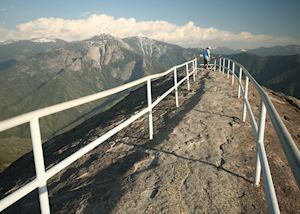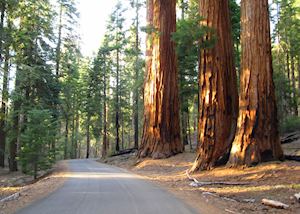Jump to:
Trees that tower like skyscrapers. A looming granite dome with sweeping views. The carved trunk of a fallen tree, big enough for a car to pass through. These are just some of the sights that await you at Sequoia National Park, home to five of the ten tallest trees in the world. One of the most southerly of the Sierra Nevada national parks, it’s located in California, positioned centrally between Las Vegas, San Francisco and Los Angeles.
Anchored by General Sherman, the largest tree in the world, Sequoia National Park offers a museum, hiking and climbing trails to take in the views and a restaurant that features locally sourced ingredients for a post-hike dinner. Some hikes and drives throughout the park are seasonal, so your specialist can outline which ones fit into your trip, depending on when you want to go.
Giant Forest Museum
A converted historical market building, the Giant Forest Museum can introduce you to the primary features of the Giant Forest. Learn more about the life cycle of the sequoias, what’s being done to protect these giant trees and about the park’s local flora.
While driving to the museum, keep an eye out for Tunnel Log, a sequoia that fell in 1937 and has had an arch carved into it to allow cars to pass through. After visiting the museum, you can head into the fresh air and explore the self-guided trails that lead from the museum to the Round Meadow and Hazelwood areas. The trails were recently rebuilt using boardwalk, bridges and split-rail fencing so that you can enjoy the meadows and trees without harming the soil, plant life, wildlife or natural drainage patterns.
A walk in the park
Sequoia National Park offers hiking trails suitable for both those looking to climb 400 steps up a steep granite rock or those looking to take a gentle stroll through the sequoias.
 Moro Rock is an imposing granite dome, visible to all driving into the park from the south. To reach the top and take in the view, you’ll follow a 4.82 km (3 mile) trail. From there, the path leads up 400 steep stone steps, where you’re rewarded with a panoramic vista of the valley below, featuring the white-topped Sierra Nevada peaks. Be warned, Moro Rock rises 2,053 metres (6,735 feet) above sea level, and the altitude can take its toll on hikers.
Moro Rock is an imposing granite dome, visible to all driving into the park from the south. To reach the top and take in the view, you’ll follow a 4.82 km (3 mile) trail. From there, the path leads up 400 steep stone steps, where you’re rewarded with a panoramic vista of the valley below, featuring the white-topped Sierra Nevada peaks. Be warned, Moro Rock rises 2,053 metres (6,735 feet) above sea level, and the altitude can take its toll on hikers.
There are also a number of short walking trails that lead you through the park, giving you an up-close-and-personal look at the immense trees and the wildlife that inhabits them — keep an eye out for chipmunks, black bears, deer and coyotes. We recommend the Congress Trail, a paved 3.2 km (2 mile) walking trail that will lead you right to General Sherman.
General Sherman
Believed to be the largest tree on Earth, General Sherman soars 84 metres (275 feet) into the sky and measures over 11 metres (36 feet) wide at the base — for now. Each year General Sherman grows enough wood to make another 18-metre (60-foot) tree. Estimations put the colossal tree at more than 2,200 years old. General Sherman was named for American Civil War general William Tecumseh Sherman in 1879.
A scenic drive
Sequoia National Park offers a plethora of scenic drives, with views of mountain peaks, frothy waterfalls and deep canyons. We recommend the hour-long drive from Grant Grove to King’s Canyon and Cedar Grove to see a little bit of everything.
 You’ll make a stop at Junction View, where you can take in the jagged tops of the mountains. The next stop sends you looking the opposite direction — directly down onto the foam-topped waters of the Middle Fork and South Fork of the Kings River.
You’ll make a stop at Junction View, where you can take in the jagged tops of the mountains. The next stop sends you looking the opposite direction — directly down onto the foam-topped waters of the Middle Fork and South Fork of the Kings River.
You’ll soon be headed toward Boyden Cavern. In the summer, visitors can take a tour of the marble cavern and see the layers of marble between strips of volcanic rock. The stalagmites and stalactites in the cavern are so plentiful it gives the illusion that the cavern is melting.
If you need a shady spot to cool off from the California sun, head to Grizzly Falls next. The waterfall spills chaotically onto the boulders 24.38 metres (80 feet) below, providing a nice area to stop and rest.
Best time to visit Sequoia National Park
Though you can visit California year-round, with much of the state experiencing warm and sunny summers and cooler wet winters, inland locations like Sequoia National Park follow a more typical four-season cycle.
The spring is a great time to visit, as the weather is generally temperate and ideal for exploring the outdoors. American schools are still in session, so hiking trails will be quieter as well.
who's been there

Start planning your tailor-made trip to Sequoia National Park by contacting one of our California specialists
-
01993 838 92501993 838 861
- Make an enquiry
Suggested itinerary featuring Sequoia National Park
This sample itinerary will give you an idea of what is possible when you travel in Sequoia National Park, and showcases routes we know work particularly well. Treat this as inspiration, because your trip will be created uniquely by one of our specialists.
Places near Sequoia National Park
- Kings Canyon National Park 33 miles away
- Death Valley National Park 83 miles away
- Yosemite National Park 110 miles away
- Pismo Beach 149 miles away
- Santa Barbara 157 miles away
- Los Angeles 171 miles away
- Big Sur 181 miles away
- Monterey 186 miles away
- Carmel 187 miles away
- Las Vegas 191 miles away
- Lake Tahoe 198 miles away
- Sacramento 217 miles away
- Palm Springs 218 miles away
- San Francisco 231 miles away
- Napa Valley 241 miles away
- Sonoma 248 miles away
- San Diego 273 miles away
Photos of Sequoia National Park
Accommodation choices for Sequoia National Park
We’ve selected a range of accommodation options for when you visit Sequoia National Park. Our choices usually come recommended for their character, facilities and service or location. Our specialists always aim to suggest properties that match your preferences.
-
![Wuksachi Lodge, Sequoia National Park]()
Wuksachi Lodge
Sequoia National Park







